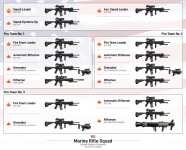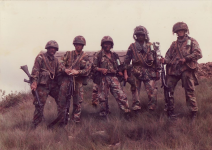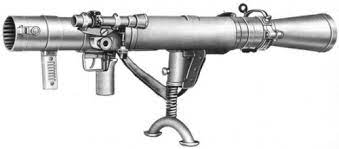Yes. In the Canadian context. We moved away from an "asymmetric section" that we used for six decades to a "symmetric approach" that mimicked the American Army. I'm not convinced it was the right decision.
I alluded to this before, but number really isn't important. I'd offer that first principles are, so here is my guess at first principles:
- Infanteers don't do things as individuals, but as teams. The fundamental building block is a team/group/detachment/brick (call it whatever you want) of 3-6 infanteers. A section is a group of teams. Multiple observations in combat support this; dismounted infanteers will tend to move in little gaggles from a good position of fire to another good position of fire.
- For Canada, each team is controlled by a junior NCO (MCpl). Each section is controlled by a senior NCO (Sgt). A Sgt can also command his or her own team as well as the section as a whole.
- A team can be assigned one "thing" to do; these "things" are broadly defined by the core functions of Find, Fix, Strike. In a rifle platoon (and even company), I'd argue there are two things a team could do - support (engage with crew served weapon) or assault (close with an enemy/protect the crew served weapon. So a section, platoon, and company is composed of a variety of assault and support teams.
- History tells us that shock wins engagements, shock comes from neutralization, and neutralization comes from the suppressive and destructive power of crew served weapons. Crew served weapons also have the advantage of encouraging participation of those who would otherwise be non-firers; repeated observations (beyond S.L.A. Marshall) have demonstrated that some soldiers simply bow out of engagements due to the psychological effect of battle. A crew served weapon, requiring a team to operate, reinforces participation. A crew-served weapon is more than the sum of its parts, and is at the core of Infantry effectiveness.
- History tells us that assault elements are not generally required to be too large. Tactical case studies continuously indicate that high ratios of support:assault elements tend to be the most successful (in Rommel's case in WWI, 8:1 support:assault was not uncommon). Support elements suppress and neutralize enemy, and assault teams clean up and secure.
- In the attack, support elements "fire in" assault elements. In the defence, assault elements provide protection to support elements that do all the killing.
- Only in specific cases would sections, and even platoons, operate on their own, so when you organize a section, you should consider how it would be used within the context of a platoon. Likewise, when you organization a platoon, you should consider how it would be used in the context of a company.
Based on these first principles, I'd argue that a section should be able to find, fix, and strike. A section with an assault team and a support team can find with either (usually just by spotting something), fix with a support team, and strike with the assault team. It is, as I mentioned above, difficult to conceive of a situation where a section is taking a single objective completely on its own. So the platoon has to be able to configure its sections and teams to find, fix, and strike. As mentioned above, the ratios for doing this are not equal, so most of the platoon can be fixing while a small element strikes. The same phenomenon exists for a company; as there is rarely a lone enemy squad wandering around waiting to fight, in isolation, with a platoon.
So, how does the Canadian Army organize its sections? In the mechanized context, let's keep our restraint of 7-seats in a LAV, as there is little point to sweeping this away for some other platform if you want to have a concept that is actually useful for us today. This gives us a 7-pers section. 1x Sgt (Sect Comd) composed of an assault team and a support team. The assault team is three soldiers with rifles (perhaps one with a grenade launcher), while the support team is a two-person weapons team led by a MCpl (Sect 2iC). The weapons team can be equipped with a GPMG or a Carl G (mission dependent), which to me are the mainstays of the infantry platoon - the GPMG for the sustained suppressive power, and the Carl G for its neutralization power in a close fight. The Sgt, if he or she wishes, can take command of the support team and send the 2iC with the assault team, and could also kick the grenadier over to the support team. Flexibility is the key.
Now pair this up with a LAV 6. This team dismounts and gets behind the LAV or (even better) a tank. They "handrail" the vehicle into a suitable position relative to their objective, providing protection to the vehicle that possesses a preponderance of firepower. The support team breaks off to a position of fire, and the assault team cleans up. Note that even in a mechanized organization, terrain may not permit intimate support, so sections and platoons require a degree of independence - even though a LAV or tank could provide all the suppressive fires required, it shouldn't be expected to.
We can't design sections without considering platoons. A Canadian platoon could be 21 pers (3 veh), 28 pers (4 veh), or 35 pers (5 veh). I think we are fine with our four vehicle loadout, so lets stick with 28 pers. Three sections as organized above, with a small HQ (a platoon commander, his or her signaller, and a platoon 2IC) and a Platoon support team; this team can consist of a MCpl comd, a platoon designated marksman, and two-pers with a crew served weapon (GPMG or Carl G, perhaps even a MRAAW - Spike or Javelin - that is carried in the HQ LAV). Again, flexibility is the key. Tactically, the most basic configurations on the attack would see the Pl Comd can mass his or her 4x support teams under the Pl 2IC to fire in 2-3 assault elements that he or she leads and, in the defence, would have the Coy Comd site the 4x support teams of each platoon, and the Pl Comd emplace the 3 assault teams in positions that provide protection to those hardened bases of fire.
Moving away from a mechanized setting and looking at light infantry (which we define as "vehicle agnostic"), I wouldn't go much larger as I think fitting a platoon into a Chinook (max 33-pers in seats) is a useful guide to apply. I'm not going to split hairs and say 32 is better than 28, but I'd offer that there is a certain elegance with simply keeping the same organization throughout. Since a Light Company does not have the firepower of the LAVs, it should have a Weapons Platoon, which we now have in the CA LIBs, to supplement the Rifle Platoons. A Weapons Platoon is simply a bunch of sections composed of support teams.
Note: history also teaches us that in a conventional war with a regular adversary, infantry sections and platoons will take casualties and generally always operate with less people than the book says. This is one reason why arguing over "6 versus 8 versus 12" is so silly and pointless; you won't have any of those numbers after crossing the LD! In the face of this reality, Section and Platoon commanders need to always remember principle (4); keep those crew-served weapons manned. I can think of a bunch of different ways a platoon of 19 organizes itself on week two of a war because it has taken casualties in the preceding days.









